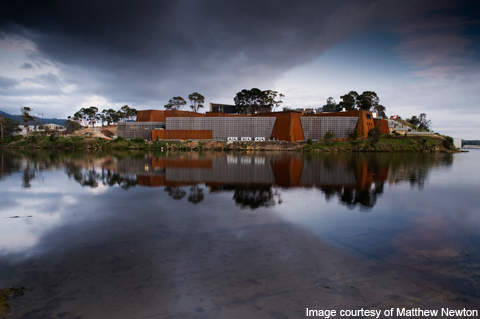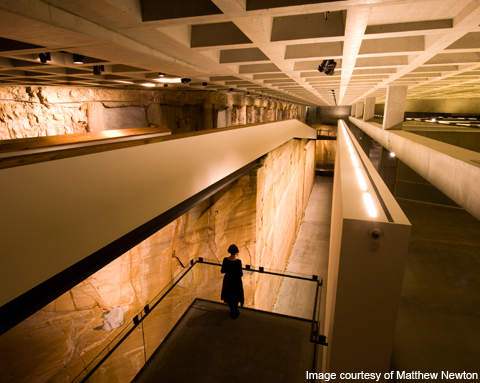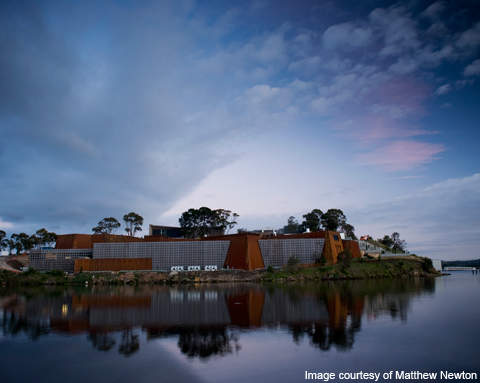The Museum of Old and New Art (MONA) is an art museum located at the suite of Moorilla Estate along the Derwent river vineyards, 12km north of Hobart city. The museum has been created by renovating the Moorilla Museum of Antiquities which was founded in March 2002 and closed in May 2006. The A$75m renovation project was started in 2007 and was completed in 2010.
MONA is the largest private museum in Australia, owned by the art collector and entrepreneur David Walsh. It has modern art and antiquities from all over the world.
Fender Katsalidis Architects in collaboration with Antarctica Group designed the MONA. The building covers an area of 9,500m² in a 3.5ha site. The new museum opened to public in January 2011.
Facilities
The underground art museum has 6,000m² of exhibition space, theatre, gallery, and art conservation and administration area. The site also includes eight chalets called MONA Pavilions, a restaurant, winery, Moo beer brewery, a boutique, walkways, penthouse and private tennis court.
Other features include a cinema for video works, a waterfall installation, crimson velvet-lined gallery and a water covered gallery floor.
MONA design
The MONA building is carved into the Triassic sandstone cliffs of the Berriedale peninsula. The museum is a three level subterranean building and lies 12m below the sandstone rock face on the banks of Derwent River. It has been built by undercutting the two existing Roy Grounds cliff-top buildings.
The heritage listed buildings designed by architect Sir Roy Burman Grounds have been incorporated into the new MONA museum. The Round House has been turned into a museum library, while Roy Grounds House has been transformed into the entrance for the underground museum.
The rust-coloured building and the roof gardens create a dynamic between the building and the environmental landscape.
The MONA pavilions, also designed by Fender Katsalidis, are diamond shaped angular boxes made of steel and glass.
Structure
The structure is made of post tensioned beam and 2,100 waffle forms for roof. The roof sections are removable to lift bulky artworks into the building gallery. The structure required 6,000m³ of concrete and is supported by 70 piers bored into the sandstone cliff face.
Construction
The subterranean Museum of Old and New Art is 140m-long and 30m-wide and anchored by rock. Construction of the exposed rock face required mining techniques. The carved sandstone forms the walls of the museum.
The engineering feat required excavation and removal of about 35,000m³ of sandstone and other material from the site. The underpinning of the two heritage listed buildings and excavation took 10 months for completion.
Interior design
A glass lift and a spiral stairway provide access to the subterranean museum galleries through dark. A Corten steel MC Escher-type staircase of 13, 2.5t fabricated flights connects the three levels. The exhibition levels are also interlinked by rising ramps and rust-red Corten steel walkways.
The cultural museum and the library are connected by a 40m-long internal tunnel and lift shaft. The tunnel is built with 2.7m diameter stormwater pipes of concrete.
The building sinks below the ground level in the interior. The air conditioning system is concealed by the floating art display walls that lie above the floor.
The building features an exposed 14m-high, 140m-long sawn sandstone wall. All the conduits including fibre optic cabling (70km), submain cabling (10km), lighting track (2.5km) and data cabling (30km) are hidden by the concrete structure.
The traditional canvases, contemporary artworks and ancient artefacts are placed side by side with geometric arrays of lights.
Visitors can know the details of artworks by a position-enabled, handheld navigator device called “O”.
Materials
The exterior is clad in concrete and Corten steel panels. Floors of the first and third level galleries are of polished concrete, while the middle level is of recycled Jarrah timber.
Contractors
Hansen Yuncken was the builder, Johnstone McGee & Gandy was the civil engineer and Felicetti was the structural engineer. WSP Lincolne Scott was the services engineer and Coffey was the geotechnical engineers. The design assistance for the museum’s Art and Display wall framing was provided by Rondo.
Tandem Design Studio was involved in the schematic design and planning submission. Local contractors were hired for laying flagstones, tiles and steel fabrications.
Landscaping at the pavilions has been done by Oculus Landscape Architecture and Urban Design.










